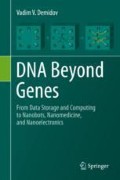Abstract
When James Watson and Francis Crick described in a succinct 1953 report to Nature magazine their model of the DNA structure—the double helix—they clearly noted its importance for storing genetic information in a witty concluding remark [1]: “It has not escaped our notice that the specific pairing we have postulated immediately suggests a possible copying mechanism for the genetic material.” Namely this specific pairing of DNA nucleobases with the unique double-helical shape of DNA molecules, which looks much like a spirally twisted ladder with two rails counterparting each other and being capable of coming apart like a zipper to enzymatically replicate this ladder in two identical copies, gives DNA the power to serve with great precision as a universal genetic information carrier for all living beings on Earth.
Access this chapter
Tax calculation will be finalised at checkout
Purchases are for personal use only
Notes
- 1.
Foresight Institute is a leading nonprofit organization researching and fostering technologies of fundamental importance for the human future, focusing on molecular machine nanotechnology, cybersecurity, and artificial intelligence.
- 2.
Drexler’s original worry, shared later by other scientists, was about the feasible danger of replicating abiotic or mechanical biovorous nano-assemblers—parts of imaginary in vitro nanoscale factories capable of reproducing themselves—which could be developed in the lab by future nanotechnologists, and could then accidentally get away into the living world, where they consume the entire biosphere in a ravenous quest for fueling food, after which nothing remained there but an immense artificial mass of nano-assemblers he called “gray goo.” Yet, this hypothetical gray goo scenario is well applicable to artificial biotic nanoreplicators, too.
- 3.
The NIH Recombinant DNA Guidelines were first issued in 1976 in the Federal Register, and they are overseen and continually revised by the NIH Recombinant DNA Advisory Committee, who reviewed all related research activities in accordance with these guidelines.
- 4.
There are many additional dimensions of safety controls that can be engineered into designs for replicators, as discussed in the Foresight Guidelines for Responsible Nanotechnology Development (https://foresight.org/guidelines/current.php#Replicators).
References
Watson JD, Crick FHC (1953) Molecular structure of nucleic acids: a structure for deoxyribose nucleic acid. Nature 171:737–738
Linko V et al (2016) DNA-based enzyme reactors and systems. Nanomaterials 6:E139
Silverman SK (2016) Catalytic DNA: scope, applications, and biochemistry of deoxyribozymes. Trends Biochem Sci 41:595–609
Watson SM, Mohamed HD, Horrocks BR, Houlton A (2013) Electrically conductive magnetic nanowires using an electrochemical DNA-templating route. Nanoscale 5:5349–5359
Dugasani SR et al (2013) Magnetic characteristics of copper ion-modified DNA thin films. Sci Rep 3:1819
Kawabe Y, Sakai KI (2011) DNA based solid-state dye lasers. Nonlin Optics Quant Optics 42:273–282
Hu X, Mu L, Zhou Q, Wen J, Pawliszyn J (2011) ssDNA aptamer-based column for simultaneous removal of nanogram per liter level of illicit and analgesic pharmaceuticals in drinking water. Environ Sci Technol 45:4890–4895
Nulf CJ, Corey DR (2002) DNA assembly using bis-peptide nucleic acids (bisPNAs). Nucleic Acids Res 30:2782–2789
Kuhn H, Cherny DI, Demidov VV, Frank-Kamenetskii MD (2004) Inducing and modulating anisotropic DNA bends by pseudocomplementary peptide nucleic acids. Proc Natl Acad Sci U S A 101:7548–7553
Breitenstein M, Nielsen PE, Holzel R, Bier FF (2011) DNA-nanostructure-assembly by sequential spotting. J Nanobiotechnol 9:54
Flory JD et al (2014) Purification and assembly of thermostable Cy5 labeled γ-PNAs into a 3D DNA nanocage. Artif DNA PNA XNA 5:1–8
Pedersen RO, Kong J, Achim C, LaBean TH (2015) Comparative incorporation of PNA into DNA nanostructures. Molecules 20:17645–17658
Jasinski D, Haque F, Binzel DW, Guo P (2017) Advancement of the emerging field of RNA nanotechnology. ACS Nano 11:1142–1164
Win MN, Smolke CD (2008) Higher-order cellular information processing with synthetic RNA devices. Science 322:456–460
Li M et al (2018) In vivo production of RNA nanostructures via programmed folding of single-stranded RNAs. Nat Commun 9:2196
Lin C et al (2008) In vivo cloning of artificial DNA nanostructures. Proc Natl Acad Sci U S A 105:17626–17631
Drexler KE (1986) Engines of creation: the coming era of nanotechnology. Anchor Press/Doubleday, New York
Vogel M, Weigand JE, Kluge B, Grez M, Suess B (2018) A small, portable RNA device for the control of exon skipping in mammalian cells. Nucleic Acids Res 46:e48
Groher F et al (2018) Riboswitching with ciprofloxacin—development and characterization of a novel RNA regulator. Nucleic Acids Res 46:2121–2132
US Congress Office of Technology Assessment Report (1984). Commercial Biotechnology: An International Analysis. Appendix F: Recombinant DNA Research Guidelines, Environmental Laws, and Regulation of Worker Health and Safety, US Government Printing Office
Robertson MP, Joyce GF (2014) Highly efficient self-replicating RNA enzymes. Chem Biol 21:238–245
Kim J, Lee J, Hamada S, Murata S, Park SH (2015) Self-replication of DNA rings. Nat Nanotechnol 10:528–533
Dodd MS et al (2017) Evidence for early life in Earth's oldest hydrothermal vent precipitates. Nature 543:60–64
Betts HC et al (2018) Integrated genomic and fossil evidence illuminates life's early evolution and eukaryote origin. Nat. Ecol Evol 2:1556–1562
Crick FHC, Wang JC, Bauer WR (1979) Is DNA really a double helix? J Mol Biol 129:449–461
Author information
Authors and Affiliations
Rights and permissions
Copyright information
© 2020 The Author(s), under exclusive licence to Springer Nature Switzerland AG
About this chapter
Cite this chapter
Demidov, V.V. (2020). Concluding Remarks. In: DNA Beyond Genes. Springer, Cham. https://doi.org/10.1007/978-3-030-36434-2_6
Download citation
DOI: https://doi.org/10.1007/978-3-030-36434-2_6
Published:
Publisher Name: Springer, Cham
Print ISBN: 978-3-030-36433-5
Online ISBN: 978-3-030-36434-2
eBook Packages: Biomedical and Life SciencesBiomedical and Life Sciences (R0)

